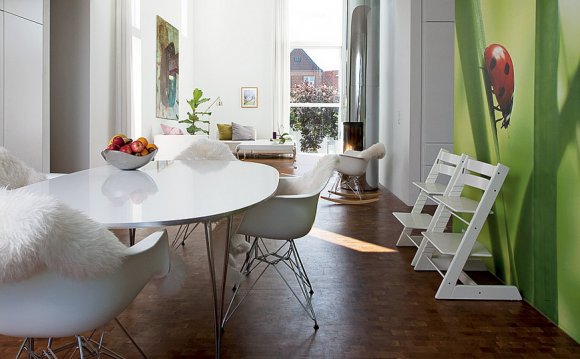

An autonomous approach and a high degree of diversity characterise the Norwegian design research environment. New initiatives emerge from the individual academic and professional fields. That produces a strong environment but also requires efficient cooperation across institutional boundaries, says Petter Øyan, head of Norway’s Professional Council for Design Education, and Rachel K.B. Troye, pro-rector and head of the Institute of Design at the Oslo School of Architecture and Design.
By Trine Vu
Norway is a skier racing down the mountain slope with ease and grace. A knit woolen sweater with a red and blue pattern. The wooden Tripp Trapp chair that is found in so many families with young children.
Norwegians often take their own unique approach to things. That is also true of Norwegian design research, which is characterised by a high degree of autonomy and diversity, according to, among others, Petter Øyan, head of the Professional Council for Design Education.
The Professional Council for Design Education is a national council under the Norwegian Association of Higher Education Institutions. It represents the state-run design education institutions and, among other purposes, facilitates their mutual cooperation.
“Norway has no national master plan for design research. On the contrary, there are many actors working on many different levels. It’s a fairly autonomous process with very little top-down management, ” says Petter Øyan and adds with a smile that the decentralised structure may also reflect the fact that Norwegians are simply averse to top-down management.
Strong Norwegian design research environment. Petter Øyan, head of the Professional Council for Design Research in Norway, says that Norwegian design research is motivated by ambitions in the individual academic or professional environments, and that this helps create a strong design research environment.
Photo: Olav-Johan Øye
A Strong Environment
Petter Øyan is also dean of the Faculty for Technology, Art and Design at Oslo and Akershus University College of Applied Sciences. He explains that Norwegian design research is motivated by ambitions in the individual academic or professional environments, which is a great advantage.“The individual schools have ownership of the design research and its focus. They are free to decide which research tasks and grants they want to take up, and that produces a great sense of pride in achieving good results and having an impact on development. It also helps build identity for the individual institution, and this is where the diversity comes in: The institution chooses and promotes its own identity, which differs slightly from the identity of other institutions – and that is a source of strength, ” says Petter Øyan.
 Three Pillars
Three Pillars
The Norwegian design research environment rests on three pillars: University colleges, universities and art colleges. The schools offer their own unique design education programmes but cooperate, for example via the professional council, to distribute tasks and avoid redundancies such as identical master’s programmes.
In addition to state-run institutions such as the Oslo School of Architecture and Design, the Norwegian University of Science and Technology – Trondheim, the Bergen Academy of Art and Design and the Oslo National Academy of the Arts there are a number of private institutions.
Only the university in Trondheim and the Oslo School of Architecture and Design offer PhD programmes in design, but if students enrolled in other institutions wish to earn a PhD they can do so via the two schools.
“The schools pursue different angles in their design education programmes, and that gives prospective design students a real choice – like a painter’s palette, ” Petter Øyan explains and mentions that the Bergen Academy of Art and Design for example has a unique scholarship programme with focus on artistic development work. Students are granted a three-year scholarship to undertake artistic work and are required to produce a work of art at the end of the three-year process. The degree of theory and reflection in the artistic process may vary, but the scholar acquires artistic competences as Research Fellows that are treated as equivalent to a PhD degree.
Two national councils contribute to the development of the design field: One is the Norwegian Design Council, which has a commercial focus and aims especially to help Norwegian companies increase innovation by means of design. Among other activities, the council runs the DIP programme – a design-driven innovation programme funded by the Norwegian government with the goal of promoting companies’ use of design. The other council, Norsk Form, focuses on communication and the exchange of design knowledge and user experiences with design.
More cooperation in the future. Cooperation is the keyword for the future design environment in Norway, says Rachel K.B. Troye, pro-rector and head of the Institute for Design at the Oslo School of Architecture and Design.
Photo: Norsk Designråd
Current Challenges Require Many Types of Designers
The diversity and the collaborative spirit that characterise the Norwegian design environment are also viewed as key qualities by Rachel K.B. Troye, who is pro-rector and head of the Institute for Design at the Oslo School of Architecture and Design.“It is an ongoing debate whether the design field is too diverse. But I believe that the diversity is necessary, because society and the challenges we are currently facing require very different types of designers, ” says Rachel Troye and mentions that in recent years, for example, there has been a growing demand for service and interaction design.
The diversity is, not least, evident at the Oslo School of Architecture and Design. The school’s design research projects range from technology and business to culture and innovation. The development of design research here has been very strategic and involved both external and internal partners and a broad research agenda. The school places particular emphasis on accessibility in design and is now specialising in service and interaction design.
Design Helps Victims of Sexual Assault
As an example of the wide scope of the design profession, Rachel Troye mentions a diploma project: Designing for dignity, where two design students from the Oslo School of Architecture and Design analysed the procedure in place for dealing with victims of sexual assault.They spoke with police, healthcare professionals and rape crisis centres, documenting and visualising all the issues in the process. They examined the procedure from the victims’ point of view, and since police, healthcare professionals and crisis centre staff were all very interested in the new knowledge that was emerging about the issue, the students brought them together in a workshop where they identified the sore spots in the process and began to develop new design solutions.
RELATED VIDEO











